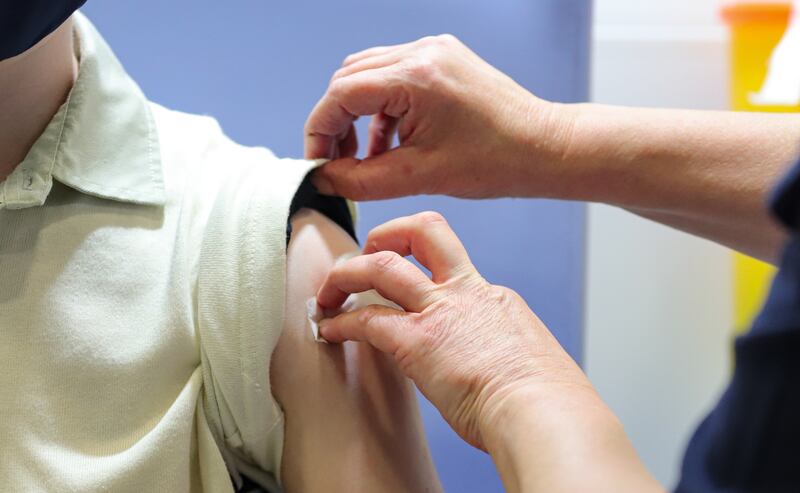The overall rates of Covid-19 in England are higher than they have ever been, a study that has been collecting data since May 2020 shows.
Researchers suggest the increase is being driven by infections in children aged between 5 and 12, and those aged 13 to 17.
The prevalence observed among the younger age group was 5.85 per cent, while in the older bracket it was 5.75 per cent.
Across England it was 1.72 per cent, compared with 0.83 per cent in September 2021.
In January this year, after the Delta variant took hold, the prevalence was estimated to be 1.57 per cent.
But the study did not run in December last year when the peak of the second wave occurred.
Prevalence refers to the proportion of the participants, in this case 67,208, who tested positive during the study period of October 19 to October 29.
Using this data, the React-1 researchers estimated that the next highest prevalence was in “parent-aged” adults, those between 35 and 54.
Regionally, the highest prevalence was in the south-west at 2.18 per cent, with researchers saying this “might be related to widespread reports of people who tested positive using lateral flow tests going on to test negative using RT-PCR tests”.
“Reports specifically tied false negative RT-PCR results to a Covid-19 test laboratory in Wolverhampton, which received many samples from [the] south-west,” the paper continues.
In mid-October, NHS Test and Trace suspended testing operations provided by Immensa Health Clinic at its laboratory in Wolverhampton.
An estimated 43,000 people may have been given false negative PCR Covid test results, resulting in them not being isolated and possibly spreading the infection to many others.
The errors relate to test results given to people between September 8 and October 12, mainly in the south-west of England.
“We do mention that in the paper as a possible explanation why we’re seeing that cluster of cases in the south-west," said Prof Paul Elliott, director of the React programme at Imperial College London.
“Obviously, we don’t know, but I think it’s a viable hypothesis.”
The study also found there was a higher rate of the virus among those who had been in contact with a confirmed Covid case, those who lived in larger households, and those who live in households with one or more children.
While those aged between 12 and 15 in England are eligible for Covid-19 vaccines, data suggests acceptance has been slow.
“This does coincide with half-term," Prof Elliott said. "We do know that we saw a very, very similar pattern in Round 6 at the same time last year, where over the half-term period the rates dropped.
“And then actually they rebounded and went up again. So I think watching what happens in the next week, 10 days, is going to be really critical.”
Graham Cooke, professor of infectious diseases at Imperial College London, said: “Back in January of this year, the highest prevalence age group was 18 to 24.
“That’s substantially lower now and apart from school-aged children, all other age groups have a lower prevalence.
“So it’s been driven by this significant increase in prevalence in the 5 to 17-year-olds, which has gone up substantially since January.”
Prof Helen Ward, also of Imperial, said vaccination of children 12 and older was slow and that was the age group for the most infections.
“And then there’s the question as yet undecided as to whether or not even younger children might be vaccinated," Prof Ward said.
“Children are one group where it is continuing to circulate and therefore with return to school following half-term you would expect there to be more transmission going on there.
“And the parents of those children are the other age group that we saw higher increases in, and are also the age group that are not yet eligible for booster doses.
“And so if there is significant waning in the effectiveness of the vaccine after four or five months, that would overlap with that age group.
“So that is why it’s really important to continue monitoring what’s happening in the whole population, but particularly those age groups that may become vulnerable again.”
About 10 per cent of the positive samples examined in the study were a mutation of the Delta strain – AY.4.2 – and officials say they are monitoring the spread of the “variant under investigation”.
“Although the number of hospitalisations and deaths remain lower than in previous peaks, these findings are a powerful reminder that the pandemic is far from over and remains a serious threat to health and well-being," said Dr Jenny Harries, chief executive of the UK Health Security Agency.
“This new data strongly reinforces the need for all eligible age groups to get vaccinated and to take mitigating measures, such as wearing a face covering in crowded places and ensuring good ventilation indoors.
“This is particularly urgent for older people whose immunity may be waning, given that several months have passed since they received their jabs.
"I strongly encourage everyone who is eligible for a third dose or a booster shot to come forward without delay.”
UK Health Secretary Sajid Javid said: “Today’s report sends an important message that we need to stay vigilant as we head into the winter months.
“Vaccines continue to be our first line of defence against this disease and it is crucial we all get jabbed to keep the virus at bay.”






